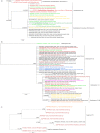Biogeography of the endosymbiotic dinoflagellates (Symbiodiniaceae) community associated with the brooding coral Favia gravida in the Atlantic Ocean
- PMID: 30849101
- PMCID: PMC6407780
- DOI: 10.1371/journal.pone.0213519
Biogeography of the endosymbiotic dinoflagellates (Symbiodiniaceae) community associated with the brooding coral Favia gravida in the Atlantic Ocean
Erratum in
-
Correction: Biogeography of the endosymbiotic dinoflagellates (Symbiodiniaceae) community associated with the brooding coral Favia gravida in the Atlantic Ocean.PLoS One. 2019 Apr 4;14(4):e0215167. doi: 10.1371/journal.pone.0215167. eCollection 2019. PLoS One. 2019. PMID: 30947299 Free PMC article.
Abstract
Zooxanthellate corals live in symbiosis with phototrophic dinoflagellates of the family Symbiodiniaceae, enabling the host coral to dwell in shallow, nutrient-poor marine waters. The South Atlantic Ocean is characterized by low coral diversity with high levels of endemism. However, little is known about coral-dinoflagellate associations in the region. This study examined the diversity of Symbiodiniaceae associated with the scleractinian coral Favia gravida across its distributional range using the ITS-2 marker. This brooding coral endemic to the South Atlantic can be found across a wide range of latitudes and longitudes, including the Mid-Atlantic islands. Even though it occurs primarily in shallower environments, F. gravida is among the few coral species that live in habitats with extreme environmental conditions (high irradiance, temperature, and turbidity) such as very shallow tide pools. In the present study, we show that F. gravida exhibits some degree of flexibility in its symbiotic association with zooxanthellae across its range. F. gravida associates predominantly with Cladocopium C3 (ITS2 type Symbiodinium C3) but also with Symbiodinium A3, Symbiodinium linucheae (ITS2 type A4), Cladocopium C1, Cladocopium C130, and Fugacium F3. Symbiont diversity varied across biogeographic regions (Symbiodinium A3 and S. linucheae were found in the Tropical Eastern Atlantic, Cladocopium C1 in the Mid-Atlantic, and other subtypes in the Southwestern Atlantic) and was affected by local environmental conditions. In addition, Symbiodiniaceae diversity was highest in a southwestern Atlantic oceanic island (Rocas Atoll). Understanding the relationship between corals and their algal symbionts is critical in determining the factors that control the ecological niches of zooxanthellate corals and their symbionts, and identifying host-symbiont pairs that may be more resistant to environmental changes.
Conflict of interest statement
The authors have declared that no competing interests exist.
Figures




Similar articles
-
Molecular diversity and assemblages of coral symbionts (Symbiodiniaceae) in diverse scleractinian coral species.Mar Environ Res. 2022 Jul;179:105706. doi: 10.1016/j.marenvres.2022.105706. Epub 2022 Jul 19. Mar Environ Res. 2022. PMID: 35872442
-
Breviolum and Cladocopium Are Dominant Among Symbiodiniaceae of the Coral Holobiont Madracis decactis.Microb Ecol. 2022 Aug;84(2):325-335. doi: 10.1007/s00248-021-01868-8. Epub 2021 Sep 24. Microb Ecol. 2022. PMID: 34561754
-
Coral microbiome composition along the northern Red Sea suggests high plasticity of bacterial and specificity of endosymbiotic dinoflagellate communities.Microbiome. 2020 Feb 3;8(1):8. doi: 10.1186/s40168-019-0776-5. Microbiome. 2020. PMID: 32008576 Free PMC article.
-
Genome Evolution of Coral Reef Symbionts as Intracellular Residents.Trends Ecol Evol. 2019 Sep;34(9):799-806. doi: 10.1016/j.tree.2019.04.010. Epub 2019 May 10. Trends Ecol Evol. 2019. PMID: 31084944 Review.
-
Gene clusters for biosynthesis of mycosporine-like amino acids in dinoflagellate nuclear genomes: Possible recent horizontal gene transfer between species of Symbiodiniaceae (Dinophyceae).J Phycol. 2022 Feb;58(1):1-11. doi: 10.1111/jpy.13219. Epub 2021 Nov 26. J Phycol. 2022. PMID: 34699617 Free PMC article. Review.
Cited by
-
Screening a Spliced Leader-Based Symbiodinium microadriaticum cDNA Library Using the Yeast-Two Hybrid System Reveals a Hemerythrin-Like Protein as a Putative SmicRACK1 Ligand.Microorganisms. 2021 Apr 9;9(4):791. doi: 10.3390/microorganisms9040791. Microorganisms. 2021. PMID: 33918967 Free PMC article.
-
Temperature-mediated acquisition of rare heterologous symbionts promotes survival of coral larvae under ocean warming.Glob Chang Biol. 2022 Mar;28(6):2006-2025. doi: 10.1111/gcb.16057. Epub 2022 Jan 5. Glob Chang Biol. 2022. PMID: 34957651 Free PMC article.
-
Correction: Biogeography of the endosymbiotic dinoflagellates (Symbiodiniaceae) community associated with the brooding coral Favia gravida in the Atlantic Ocean.PLoS One. 2019 Apr 4;14(4):e0215167. doi: 10.1371/journal.pone.0215167. eCollection 2019. PLoS One. 2019. PMID: 30947299 Free PMC article.
-
Physiological response of Symbiodiniaceae to thermal stress: Reactive oxygen species, photosynthesis, and relative cell size.PLoS One. 2023 Aug 3;18(8):e0284717. doi: 10.1371/journal.pone.0284717. eCollection 2023. PLoS One. 2023. PMID: 37535627 Free PMC article.
-
Continent-island boundary and environment-shaped evolution in the marine amphipod Ampithoe marcuzzii complex (Crustacea: Eumalacostraca: Ampithoidae).Sci Rep. 2024 Jan 5;14(1):608. doi: 10.1038/s41598-023-51049-5. Sci Rep. 2024. PMID: 38182880 Free PMC article.
References
-
- Muller-Parker G, D’Elia CF, Cook CB. Interaction between corals and their symbiotic algae In: Birkeland C, editor. Coral reefs in the Anthropocene. Springer; 2015. pp. 99–116. 10.1007/978-94-017-7249-5 - DOI
-
- LaJeunesse TC. Investigating the biodiversity, ecology, and phylogeny of endosymbiotic dinoflagellates in the genus Symbiodinium using the ITS region: in search of a “species” level marker. J Phycol. 2001;37: 866–880.
-
- Stat M, Loh WKW, Hoegh-Guldberg O, Carter DA. Symbiont acquisition strategy drives host-symbiont associations in the southern Great Barrier Reef. Coral Reefs. 2008;27: 763–772. 10.1007/s00338-008-0412-5 - DOI
Publication types
MeSH terms
LinkOut - more resources
Full Text Sources
Miscellaneous

